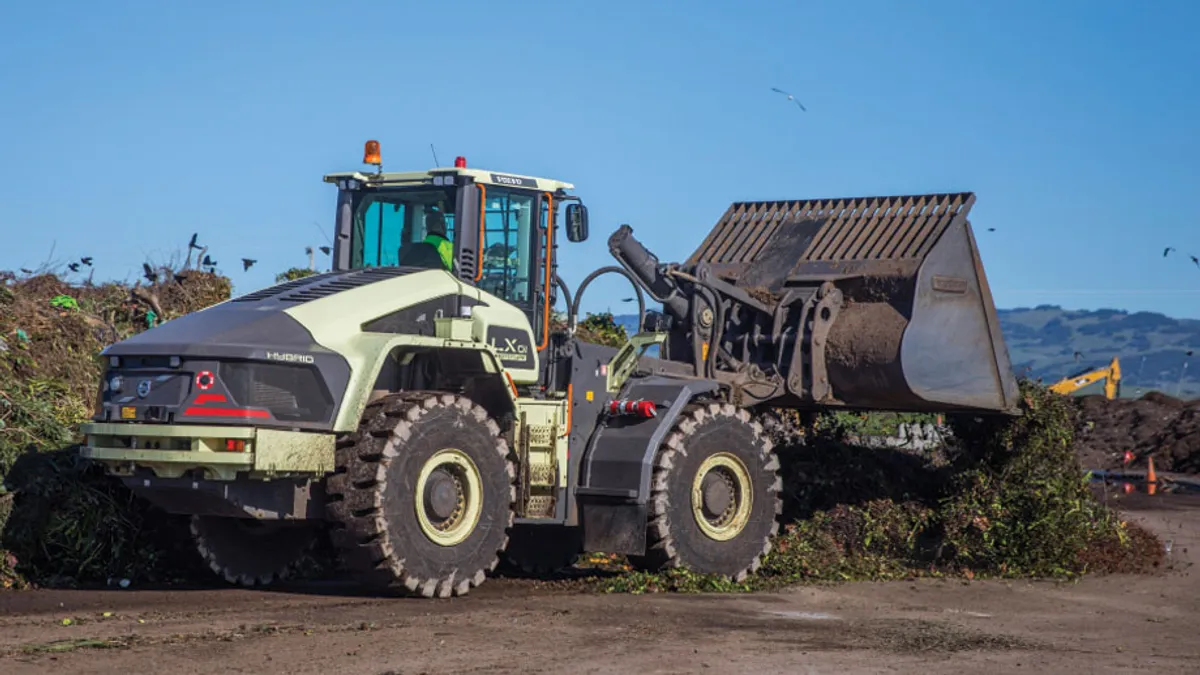Dive Brief:
- Volvo recently announced that its LX1 prototype electric hyrbid wheel loader achieved an estimated 50% fuel efficiency improvement, surpassing a goal of 35%, according to a press release. The vehicle was tested at two Waste Management facilities in California for 100 hours each.
- In addition to the reduction in fuel consumption and greenhouse gas emissions, the prototype was noticeably quieter and resulted in less wear on the vehicle's tires. The prototype design also increased visibility for drivers. Volvo plans to take these results and other driver feedback into account while it continues to work on the prototype in Sweden, with the goal of eventually making it commercially available.
- This project received $1.8 million in funding from the California Energy Commission as part of a larger renewable energy and vehicle technology program. Emissions tests were conducted by CALSTART.
Dive Insight:
Volvo first unveiled its hybrid wheel loader concept at the annual ConExpo event in 2008, but plans were delayed by the recession. It first presented the prototype idea to Waste Management, which operates one of the world's largest Volvo Construction Equipment fleets, during a meeting at their headquarters in late 2015. John Meese, senior director of heavy equipment for Waste Management, said he was immediately intrigued.
"It's quite an interesting machine." he told Waste Dive. "We'll adopt any technology that we can that gives us a cutting edge."
Meese said traditional wheel loader engines burn between 7.5 to 9 gallons of diesel fuel per day and run for the entirety of a full shift, whereas the LX1 prototype only used 4 to 5 gallons per day and its engine was active for less than half that time. This is due to the fact that the LX1 runs on a 3.5-liter engine versus a 13-liter engine in standard models.
Reduced slippage would also help cut back on the large expense of buying new tires for transfer station operations. Meese estimated that a 5-10% reduction in tire expenses could lead to six-figure savings. The vehicle's quieter profile could also deliver more savings by potentially allowing the company to apply for extended hours under local operating permits.
Meese sees a good business case for eventually using electric collection vehicles too — and the company is watching Volvo's autonomous vehicle pilot in Sweden very closely — but he said the fuel savings are "dramatically greater" for wheel loaders at the moment. Waste Management currently runs 451 such vehicles in North America, though California would likely be its first place to start deploying this hybrid model because of emissions regulations under state law AB 32.
"So if we have to spend a little bit more to meet emissions standards in California — but in doing so we can get dramatic fuel savings, tire cost savings, the potential for hours of operations savings — we'll go ahead and buy the hybrid," said Meese.
While many private companies and municipal agencies have been putting their resources into new vehicles powered by natural gas, this is a reminder that electric or hybrid options may play a large role in fleets of the future too. Wrightspeed's electric powertrain has drawn a lot of attention since its debut last year and Sacramento recently announced the debut of its first all-electric collection truck.















